Recently, a reader suggested a realistic test of holsters. A holster test that met Gun Tests criteria would have to be extensive. While we have worn holsters extensively, drawn from concealed carry, and subjected holsters to sweat, oil and solvents, the reader suggested we go further. He felt that a test should include extensive drawing from concealed carry and checking the respective handguns for finish wear. This meant a number of both leather and Kydex holsters should be tested. These holsters would be custom-grade tightly molded holsters with a good balance of speed and access. The holsters would be worn by the raters for weeks at a minimum, and the holsters would be subject to 500 total draws.
This isn’t a harsh standard. Most martial artists feel that a minimum of 500 repetitions is necessary for any movement to build confidence and speed without fumbling. One of our raters has written for Black Belt magazine and has a lifelong pursuit of martial arts under his belt. He felt that this is a rigorous but reasonable standard before deployment of a concealed-carry-holster-and-handgun combination. We suspect very few shooters would follow this regimen. The raters found that 50 draws could be tiring with any of the holsters, and the maximum effort seemed to be 70 draws in one outing.
When a new shooter or trainee begins discussing concealed carry, we offer the best qualified advice we are able. One piece of advice is that you really need two guns, a large and a small handgun, if you live in a true four-season climate. Even in warm Florida, you probably need to have a smaller gun for under the shirt or in the trousers. Another piece of advice is that a holster is a great modifier of handgun size if properly designed. A larger handgun may be carried concealed in a good holster with the proper geometry. The holster must keep the handgun secure and angled properly for a sharp presentation from concealed carry. The holsters chosen must pass this criteria.
We chose seven leather and seven Kydex holsters for the test, although two of the holsters are actually hybrids, a blending of leather and Kydex. While the difference between leather and Kydex is of prime importance in this evaluation, we also rated the handgun holsters based on speed and security. The regimen included raters wearing the holsters concealed and drawing from each holster 500 times. We also rated the holsters based on speed access and retention. While weapons wear is a concern if the piece is too valuable to allow it to wear, leave it in the safe. Working handguns are tools, not safe queens.
After the test, the raters had a good discussion concerning Kydex and leather. There are strong adherents to either. In the end, the leather holsters were more comfortable when worn long term against the body. On the other hand, Kydex holsters offer a sharp draw and good retention and are not likely to lose their shape. There are things that may be done with Kydex that would be difficult or impossible with leather. These include adding the appendix-style foot to the Werkz holster, and also adding a removeable magazine pouch to a holster. On the other hand, the DM Bullard Bodyguard–type holster crafted for the heavy single-action revolver would not come out well at all in Kydex, we feel. For concealed-carry purposes, the hybrid type with a Kydex shell and leather backing seems to be the best of both worlds, with a strong Kydex component married to a leather backing for comfort.
As for handgun wear, we feel neutral on this subject. The raters have long-serving handguns that exhibit some muzzle wear from use, but for the most part these are blued guns. We feel that modern finishes will exhibit little wear in the long term, particularly stainless-steel finishes. Either type should serve well. We do feel that appendix holsters, based on our tests, should be Kydex. A strong-side IWB worn close to the kidney over the right pocket should be leather or have a leather backing. One of our raters actually had light bruising after wearing Kydex for a month over the hip. This did not occur in the appendix position. Appendix carry demands a rigid holster without rollout, hence the Kydex recommendation. Here’s how each holster performed in more detail.
Tulster AIWB, $60
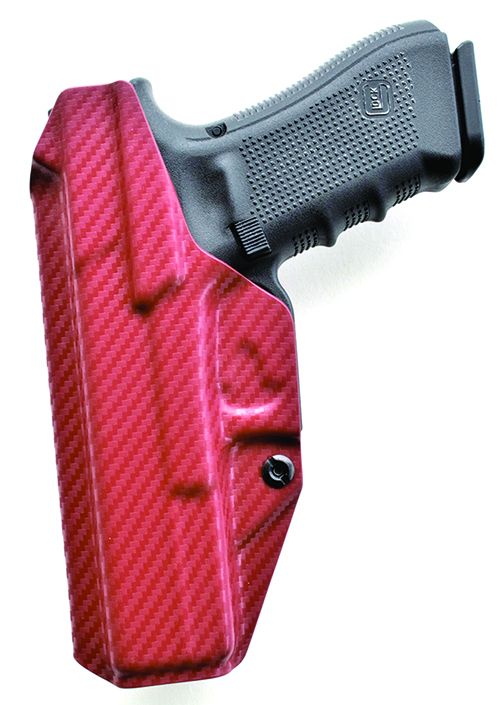
Available from Tulster.com, we also tested the Tulster ECHO magazine carrier $35. The Tulster holster is made of Kydex, a thermoplastic resin that allows the holster to keep its shape indefinitely with excellent resistance to oil, water, and solvents. The holster delivered was molded for the Glock 17 9mm. The belt clip was angled in an ideal cant for appendix carry. One of the raters has experienced back problems and was very interested in exploring appendix carry, so he did the majority of testing with the appendix-style holster and draw. The belt clip was sturdy and took a good bite of the belt. The retention screw was adjustable for a good, tight ride or a little less tension for a easier draw. The draw was sharp. The holster rode comfortably. When the handgun was holstered, there was an audible snick as the muzzle was secured. The handgun was tugged free in a clean draw. The balance of speed and retention in this holster was good to excellent.
We also tested the Tulster magazine carrier and found it to be tactically sound and secure on the belt. This unique carrier allowed tension adjustment on the magazine. The carrier was properly designed for use in conjunction with an Appendix Draw holster. During the rest program we deployed a well-used Glock 17 9mm. There was slight muzzle wear on the piece toward the top of the beveled end of the muzzle from years of use. After 500 draws and some six weeks of wear, the Glock demonstrated no further wear. We had guessed that the Glock, already worn a bit, would show considerably more wear after this test. It did not.
GUN TESTS GRADE: A (HOLSTER)
GUN TESTS GRADE: A (CARRIER)
Werkz M6 AIWB, $50
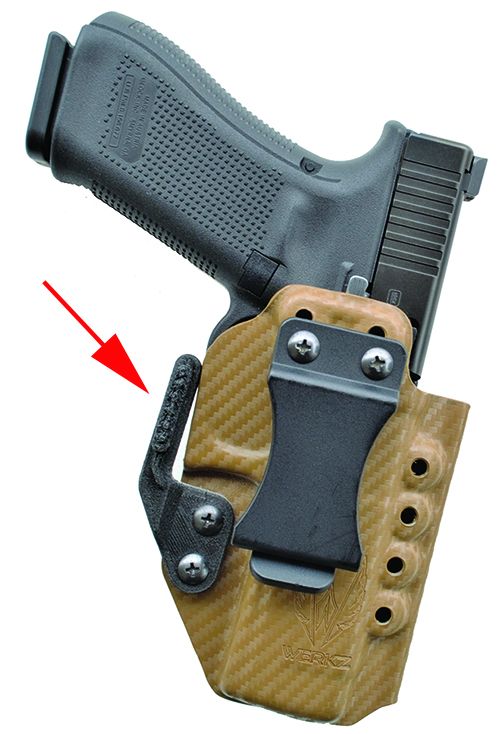
Available from Werkz.com, the Werkz IWB offers good features, including a special foot that prevents rollout in appendix carry. Rollout is a typical problem that results in the gun handle rolling out away from the body. If this foot is unscrewed and removed, the holster is well suited to typical IWB carry. The holster fit the Glock 45 9mm. One rater experimented with the AIWB carry, but he carried the holster primarily as a standard IWB holster, over the right hip. The Tulster with its angle was better suited to AIWB as tested, while the Werkz was better suited to IWB for the individual raters. The Werkz was useful for either carry. The Werkz holster offers good retention adjustment and an excellent draw. The holster’s design offers a trim package well suited to concealed carry. There was no discernible wear on the new-condition Glock 45 after it had ridden in the Werkz during the test program.
GUN TESTS GRADE: A
Werkz Bisect, $95
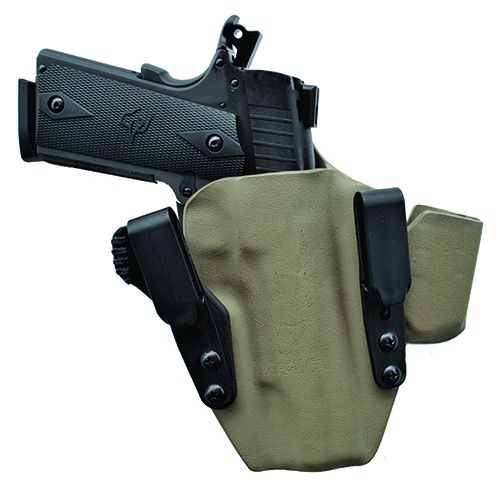
The Bisect is the most expensive Kydex holster tested. As such, it should have good features. It did. The Bisect as delivered features a belt bumper that serves as an anti-rollout device, the same as the foot on other holsters. This one is located neatly under the belt attachment. For behind-the-hip carry as a standard IWB, the bumper may be removed. The holster is supplied with a magazine pouch. When used in the AIWB position, the addition of a magazine carrier makes good tactical sense. Magazine deployment is easier than carrying the magazine carrier on the non-dominant-hand side. The belt attachments feature liberal adjustment range for AIWB or IWB carry at different cants. There was also adjustment for the ride above or below the belt. We liked this holster a great deal after extensive use. It was well designed and a good fit for the Taurus 1911 45 Commander used during the test. While a closed bottom is a sign of quality with a leather holster, Kydex gear should be open at the bottom to make cleaning easier. (Concealed-carry leather holsters are short when the bottom is open as well.) Material in the holster may grind into the handgun’s finish, so Kydex should be cleaned occasionally. You simply wash the holster out with soap and water and allow it to dry. As for wear, after 500 presentations from concealed carry, the Taurus showed some wear on the muzzle area, which seems to be the primary contact point for this holster. The Taurus uses an inexpensive matte finish, and mileage on the finish may vary according to the firearm. During the initial 100 draws, the pistol was covered around the forward cocking serrations area by shavings as a result of the cocking serrations digging into the Kydex. This also happens with leather holsters. There really is little to be done, but there is a chance the material could invade the handgun and cause a hang-up. This was cleaned off from time to time and disappeared after perhaps 125 presentations.
If you delete the magazine carrier, the holster costs $30 less. Because you need a spare magazine carrier, this gets the Bisect into a much better value when all is considered. We rated the holster down a half grade based on its fit with the forward cocking serrations.
GUN TESTS GRADE: A-
Galco King Tuk Classic, $37
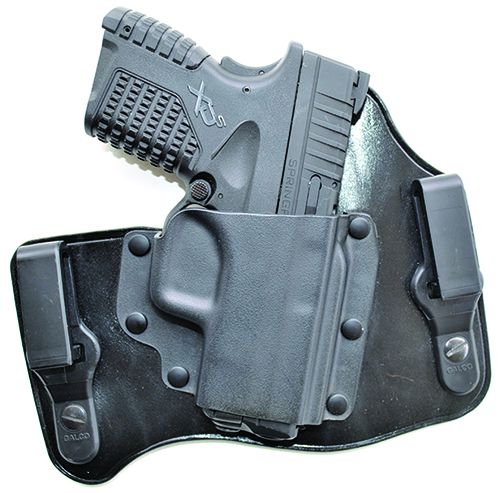
We ordered this product from MidwayUSA.com, but we saw a range of prices for this holster, ranging from the least expensive, as noted above, to shops asking $76 for the King Tut Classic. The weighted average of a dozen sites was $48. So shop around. This holster was ordered for the Springfield XDs 3.3-inch 40 Smith & Wesson. The holster showed good fit and retention. The Kydex holster component is only part of the holster’s construction, however, with the backing of supple black-finished steer hide. We liked the hybrid-style holster for its comfort. However, the foot print is larger in width than competing styles such as the Galco Triton. Just the same the primary advantage is comfort. The steerhide holster against the body is definitely a plus. Retention was good. While we do not like to count on body compression as a part of retention, the soft steerhide component allows body mass to press against the handgun. This makes for good retention. The King Tuk is a tuckable and may be completely concealed beneath a tucked-in shirt, given reasonable care. One of the raters visited hot and humid Louisiana while wearing the King Tuk Classic/Springfield combination and found it to work well. The treated steerhide did not turn dark and discolor in what the rater described as June summer seat and profuse perspiration. He also made 500 draws, but not from the tuckable position. They were done in a standard IWB-type carry to let the test proceed at a more reasonable rate. After the draws, the pistol showed some wear on the top of the slide near the front sight, reasonable for this type of testing. We find the King Tuk to be a good design well worth its price.
GUN TESTS GRADE: A
Alien Gear Cloak Tuk IWB, $39
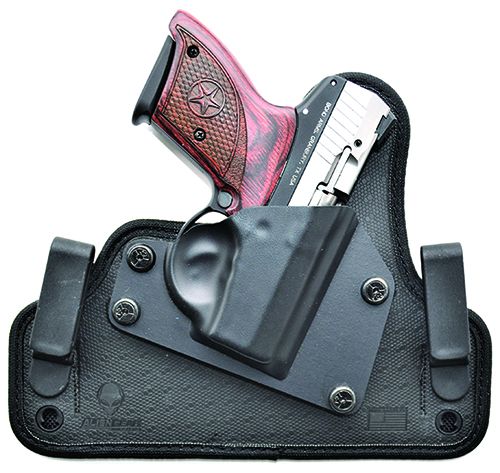
This holster was ordered from AlienGearHolsters.com for the Boberg 9mm pistol. which is the primogenitor of the Bond Arms Bullpup 9mm we were using. Our concerns were not as much for the holster as for the pistol itself. The Bond Arms pistol features a trigger guard well ahead of the usual position and a relatively short muzzle area. We wondered if a holster of conventional design could offer sufficient retention. As it turns out — it certainly does. Retention isn’t a problem. The holster holds the pistol in a good angle for a draw, and while the belt attachments are adjustable, we did not have to adjust the loops during the test program but instead concentrated on the pistol’s retention and draw speed.
This is a tuckable, and it works nicely with the shirt tucked in. Just the same, we did not draw more than a time or two from the tucked position. Ripping the shirt up and out and then drawing is slower and also adds much more time when you are executing a 500-draw regimen. The Alien Gear holster featured a synthetic backing that was comfortable and should repel perspiration well. The holster was easy to draw from and did not lose its rigidity.
The Bond Arms stainless slide showed no wear marks. When the pistol and holster were turned upside down, the pistol did not slide from the holster, but it could be shaken free with some effort. There simply isn’t much to hang onto in the case of the short-slide Bullpup. We rated the combination down a half grade based on this.
GUN TESTS GRADE: A-
DM Bullard Bodyguard Standard, $295
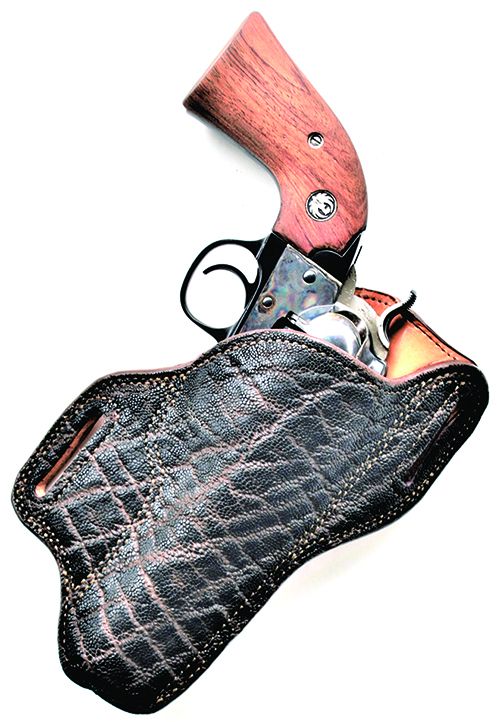
Available from DMBullard.com, the Bodyguard holster offers an alternative to the IWB for those who cannot tolerate inside-the-waistband carry, and who may wear a holster under a pulled-out sport shirt. A straight cant belt holster would present a tall holster, while the Bodyguard angles the handgun across the belt. The draw is at a severe angle, but not nearly as severe as the small-of-the-back holster, as an example. The Bodyguard as tested was ordered in hippo hide, a legal material and very difficult to obtain at times. Thus its high price. Regular leather designs run $85. This tester’s normal wear is a single-action Ruger in 44 Magnum or 45 Colt, although he may use a 45 Auto at times. The Bodyguard does an excellent job of carrying the big guns comfortably, with the weight well distributed across the belt line rather than hanging in one place and dragging down. The draw isn’t as fast as the Combat holsters offered by the same maker, or an Avenger type, but the holster succeeds at canting the handgun to an extent that a larger handgun is concealable. There really isn’t a Kydex alternative we have been able to find that equals the Bodyguard.
The angle is such that 20 draws were the limit for real speed before the tester tired. We found the draw passable, especially when the holster was worn under a heavy but unbuttoned jacket, and the primary advantage of this holster is better comfort with a heavy handgun compared to almost any other holster, in our experience. After the test was completed, there was no finish wear at all on the Ruger Bisley blue steel Vaquero. The inside of the holster was slightly polished, but no wear was apparent. We would probably recommend the standard-grade holster at $85 rather than the custom piece, but the hippo is nice if you are flush. It seems impervious to wear.
GUN TESTS GRADE: A
Blade Tech Classic OWB, $80
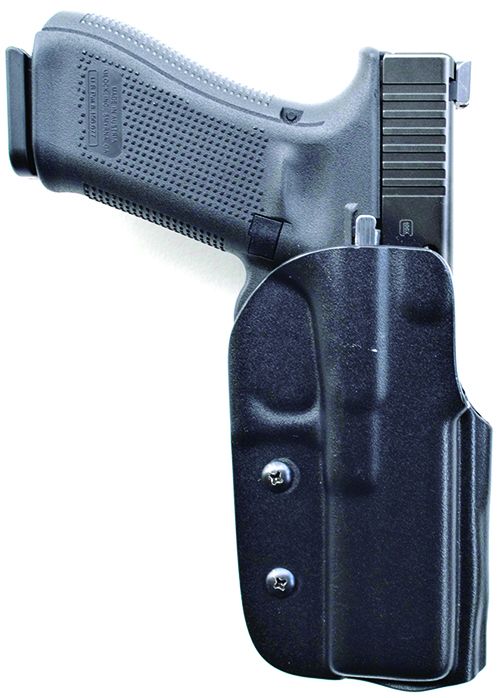
Ordered from BladeTech.com, the Classic OWB is primarily a competition-suitable holster. As such, it is designed with a speed cut out (which also neatly accommodates a pistol with optics) and a natural draw angle. The holster is very fast. Retention was good to excellent. The holster offered a rigid lock on the belt by means of a supplied Tek Lok device. The Classic was filled with a well-used Glock 9mm. Of the holsters tested, the Classic OWB offered the speediest draw and was the least tiring to execute draw after draw. However, the offset of the holster from the body isn’t designed for concealed carry. Just the same, this holster has many applications in practical range use and competition. There was no discernible wear on the handgun and no shaving of material from the holster.
GUN TESTS GRADE: A
Jeffrey Custom Leather Body Guard, $119
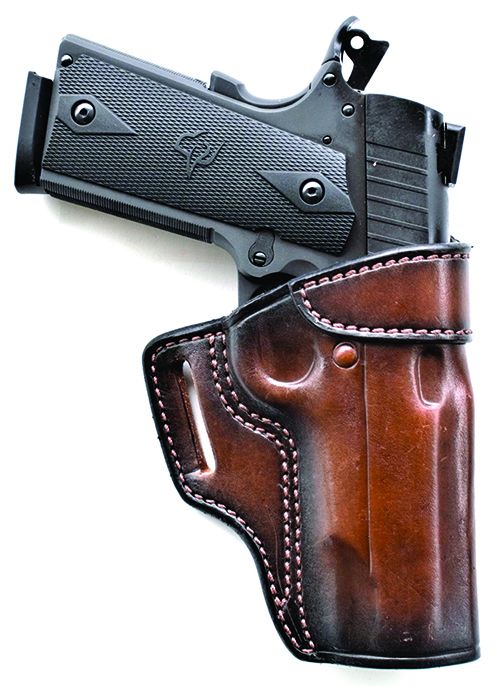
Available from the company website JeffreyCustomLeather.com, the Body Guard is referred to as an Avenger-type holster, or improved Avenger. This appears to be a simpler holster than the Professional, but it also requires considerable handwork and stitching. The Body Guard is tightly molded with a holstering welt to prevent the holster mouth from collapsing, and it has a sweat guard to protect the shooter’s body from being gouged by the sharp edges of the handgun, and also to protect the handgun from corrosive perspiration. While the holster is molded on both sides of the body, the rear tunnel loop cinches the holster tight against the body for a tight ride. In executing 500 draws from this holster with a Taurus 1911 Commander, we noticed some finish wear after, and while no bare metal showed through, the finish was definitely different in appearance.
The Body Guard is a good holster with a good balance of speed and retention. We liked the Professional (reviewed below) better by vote. The Avenger is more compact, and it is more about individual choice. The Taurus Commander also shaved leather off the interior of this holster, resulting in a half-grade demerit for the combination, but it wasn’t as severe as the Kydex holster.
GUN TESTS GRADE: A-
Jeffrey Custom Leather Professional, $119
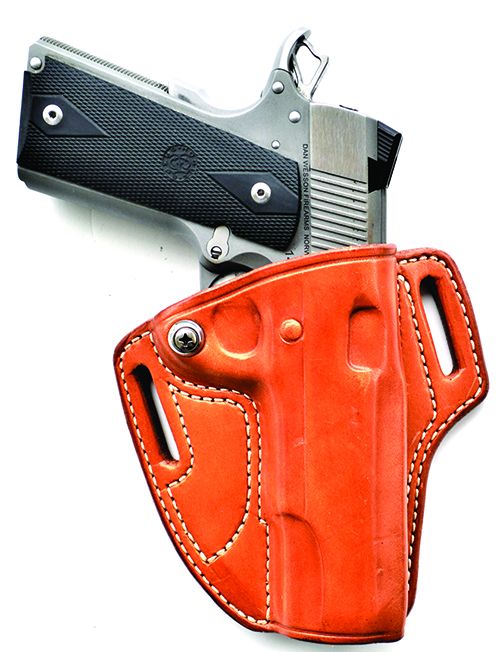
The Professional features a tightly molded body that is double stitched for rigidity. There is no backing; the Professional is molded from a single piece of leather. The back is flat, and the molding is all on the front. This is what the maker calls a Roman arch effect, in which the strength of the holster eliminates the holster collapsing, despite the fact that there is no holstering welt. A retention screw near the trigger guard controls tension. The belt loops are angled for a forward cant. There is a sweat guard, a requisite, in our opinion, for close-body carry. The holster was delivered to fit the Government Model 1911. The first 20 or so draws from leather were very tight, and the holster exhibited a good balance of speed and retention after 100 draws. Simply wearing the holster is also part of the break in. There was no discernible finish wear on the slide of the pistol involved in the testing. We find the Jeffrey Custom Leather Professional and excellent all around concealed carry holster.
GUN TESTS GRADE: A
Nelson Holsters Stealth, $120
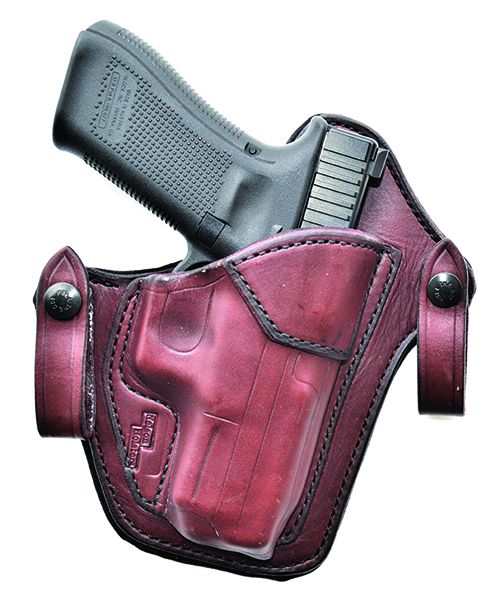
Found at Nelsonholsters.com, the Stealth is a fairly complex holster with several layers of design. The holster body is stitched onto a leather backing. The backing then features neoprene that rides against the body for comfort. The neoprene backing isn’t glued on to the holster, but is rather stitched on. The result is a holster with plenty of rigidity and one which offers a good, sharp draw from concealed carry. The dual belt loops help to spread the weight of a handgun about the body. A reinforced welt on the holster body keeps the holster mouth from collapsing. This holster isn’t lined but is waxed on the inside surface. This holster, molded for the Glock 19, was also a good fit for the Glock 45 9mm. Wear on the long bearing surfaces of the handgun tested was minimal to nonexistent. Despite being tested with a new model handgun with forward cocking serrations, there were no instances of material shaved from the holster despite our torquing the handgun from side to side.
GUN TESTS GRADE: A
JM Custom Kydex IWB3, $55
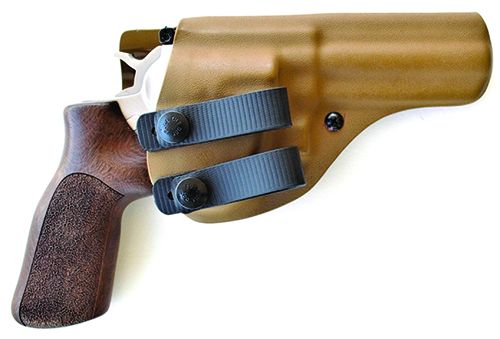
We wanted to test at least one Kydex holster molded for a revolver, here a 4-inch-barrel Ruger GP100. This is a big handgun to carry, and its weight and bulk would be a good test for the type. We think that many shooters regard the Kydex holster as a modern design for polymer-frame handguns. The Kydex type, if properly designed, has advantages for the revolver. As an example, the revolver IWB needs to keep the cylinder bulge above the belt line or the holster may fold on itself and make the draw difficult. The IWB3 features a rigid and very well molded body that will not collapse. It offers a non-collapsible pocket for the revolver cylinder. While the revolver bulge is a problem and it will never conceal as neatly as a flat autopistol, the revolver handle offers a fast, sharp draw. The IWB3 features dual belt loops set far back enough to aid in concealment and offer retention. It even offers a sweat guard, an unusual feature on revolver holsters.
GUN TESTS GRADE: A
Lobo Gun Leather Offset Belt Clip IWB, $70
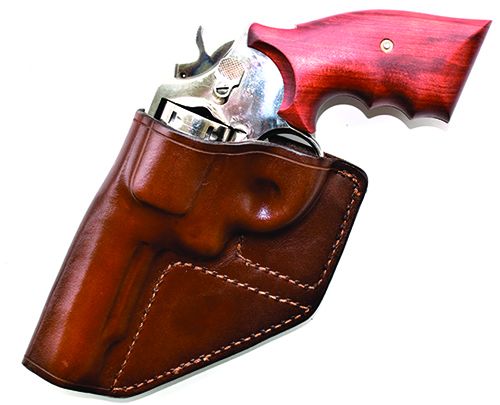
This inside-the-waistband holster, available at LoboGunLeather.com, is of conventional construction in some ways, with excellent molding, a good fit, and a reinforced holster mouth. The offset belt clip is an aid in moving the belt clip from the area of the revolver cylinder. The rear clip is also larger than most, heavily sewn onto the holster body, and manufactured of strong spring steel. We used a nickel-plated Smith & Wesson Model 13 357 Magnum. The Offset Belt Clip holster was tight to begin with and, like many quality leather holsters, demands a break-in period. After 50 presentations, the draw was quite sharp. Retention is excellent. While nickel finish is often considered more durable than bluing, nickel will crack and peel and sometimes shows brush marks and discoloration with wear. There was no wear after 500 draws with this combination. This holster is possibly the best IWB/Revolver holster we have tested.
GUN TESTS GRADE: A
Written and photographed by Gun Tests staff.



























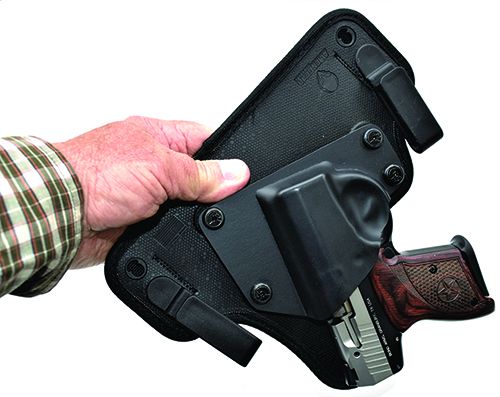


Where are the holsters with a thumb operated safety strap? IMHO a MUST for any holster, not only for retention but to assure the wearer the handgun has been fully re-inserted into the holster. Time for holster tests round two, Todd.
I agree. You are more likely to get into “wrestling “ match before guns are brought out.
How embarrassing to have your gun fall out!
Well written article with test criteria will thought out. Clear explanation of all important features for a good carry holster. I look forward to reading you newsletter every month.
Appendix carry is OK until you sit down and it sticks you in the groin and the ribs and pushes the rig up above the belt line and waves it around. It’s hard to carry it undetected and its located at your front where everybody is looking when you face them. Especially weird if you are fat and your stomach wants to roll over the top of the gun. Better be a very compact Walther TPH kind of gun for that position.